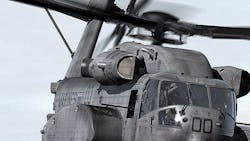General Electric’s GE Aviation business unit will follow the lead of its affiliate, GE Power Generation, and establish a new center of operations in Europe, in order to have access to export-credit financing it may need to fulfill various future projects. In its announcement, GE said the new “turboprop engine development, test and production operation” would represent an investment of more than $400 million, supporting 500 to 1,000 jobs.
GE did not identify a location for the new European center nor the schedule for its new investment there. However, it said combining the resources of GE Aviation’s turboprop facility in the Czech Republic with “ground-breaking technologies in its military and commercial jet engines” would prepare it to pursue new turboprop engines in the 1,000-1,300-shaft horsepower (shp) range and in the 1,500-2,000-shp range.
As with the earlier announcement regarding GE Power Generation, the corporation pinned the strategy to the lack of a U.S. export-credit agency able to insure the value of large engineering and equipment projects, in the interest of creating jobs for development and manufacturing capital goods as well as generating export revenue. The U.S. Export-Import Bank that formerly conducted such transactions was not reauthorized by the U.S. Congress after July 1.
“Right now, across the entire company, GE has $11 billion in sales opportunities in the pipeline requiring ECA financing,” stated David Joyce, president and CEO, GE Aviation. “The uncertainty around the Ex-Im Bank in the U.S. requires that companies like GE create alternatives in order to compete internationally.”
GE cited the $11-billion project portfolio earlier this week when it announced it would set up a “Center of Excellence” for heavy-duty gas turbine design and manufacturing at Belfort, France, drawing activities and up to 400 jobs from plants in South Carolina, New York, and Maine. It related the French location to an agreement by GE with Coface, the French export agency, for a line of financing credit to execute a series of power plant projects around the world. It will relocate the manufacturing for power turbines in order to gain the export credit.
The turboprop engine industry involves numerous smaller aircraft manufacturers around the world, and GE Aviation stated it would need financing through government-sponsored Export Credit Agencies in order to pursue such projects. It noted it has initiated discussions with several foreign ECAs, implying that locating its turboprop product development and manufacturing in Europe would help it to secure credit financing there, as appropriate.
GE Aviation also made it clear it is expanding its operations in countries where export credit financing is available, listing a Global Robotics Center of Excellence at Bromont, Quebec, and expanded engine testing operations at Winnipeg, Manitoba. In Brazil, GE Aviation will invest $55 million to expand an engine testing center at Celma.
About the Author
Robert Brooks
Content Director
Robert Brooks has been a business-to-business reporter, writer, editor, and columnist for more than 20 years, specializing in the primary metal and basic manufacturing industries.

